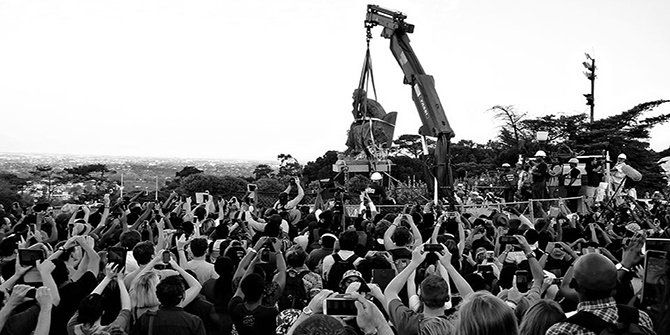There is a growing demand amongst people working in humanitarian protection and refugee studies to understand how refugees and people seeking protection participate in their own safety. Ethnomusicology has a lot to contribute to this research, but its potential is yet to be fully explored. Sylvia Nannyonga-Tamusuza introduces ethnomusicology as an approach that can complement others to understand issues of humanitarian safety and protection.
This article is based on research from the project Safety of Strangers at LSE’s Firoz Lalji Centre for Africa.
What is ethnomusicology?
A field of study whose history can be traced from the late 1800s, ethnomusicology can be explained as the study of all kinds of music (including dance) to understand people’s ways of life and how their life experiences help shape the creation, consumption and interpretation of music. It is studying music (and dance) as it relates to its larger cultural context: social, cultural, economic, political, emotional and other contexts that shape people’s lives. The study of music and associated performance activities represent rich discursive sites where social structures and cultural meanings are negotiated and affirmed.
Why study music to understand issues of humanitarian protection?
The potential of music to provide sources of data for humanitarian protection research lies in the role of music in people’s lives. For example, music being a media of communication, its study can reveal deep-seated views about experiences that may not be easily shared verbally, in contexts where open-speech is politically or emotionally controlled. Music is the voice of the voiceless. As Diane Baxter writes: ‘Music is one of the ways we make sense of our lives, one of the ways in which we express feelings when we have no words, a way for us to understand things with our hearts when we can’t with our minds’.
My own research experience has shown how women have historically used lullabies to talk about challenges in their marriages, while ‘hiding’ behind singing to sooth crying babies. Whereas the melodies target the babies themselves, the text and the message of the lullabies are expressions of unresolved issues the women have with their husbands. Because, more recently, women have increasingly joined public spaces to engage in informal economies to provide for their families, the limited time available to sing for their children has led to an increased use of technology, especially the mobile phone; ring tunes and caller tunes are used to communicate messages whose physical engagement may not be politically correct. For example, women have used clips from Judith Babirye’s song Nnwanira, Fight for Me God, evoking the intervention of God in situations of conflict with husbands and in-laws.
The Safety of Strangers project is a research project on humanitarian protection based at LSE’s Centre for Public Authority and International Development, the Firoz Lalji Centre for Africa and the University of Gulu. As part of this AHRC-FCDO grant, senior academics from Uganda, South Sudan and the UK are providing a course on humanitarian protection in theory and practice to forty early career researchers six different countries in Africa.
During the introductory class on using ethnomusicology as an approach to researching humanitarian protection, we had a moment where we shared our audio-biography, the kind of music we listen and dance to and why. One participant from South Sudan said:
‘When I was growing up, I was so much glued up to the traditional dance … When my life changed a bit; when a lot of conflicts were happening in South Sudan, a lot of killings, a lot of traumatic events, I tended to listen more to Christian music because there, I found some kind of relief to keep [out] a lot of trauma that I was having … I took [this music] as kind of my personal counselling.’
Moreover, music is an archive for historical narratives and, through studying music, we are able to retrieve past events to contribute towards reconstructing local knowledge. Another participant from Northern Uganda shared how listening and dancing to music allows her to reconstruct her childhood and youthful past:
‘When I am out with my friends, I love mostly hip-hop we can dance to, together. It brings out the young girl in me that I was like as a teenager; how I used to dance … But I prefer to listen a lot to Lakubukubu [Acoli music and dance from Northern Uganda]. It reminds me of my grandparents a lot and a lot of childhood [experiences] as we grew up. So, it keeps on bringing back a lot of memories that I had with my childhood friends and I love dancing to it.’
While musical sounds do not provide meaning on their own, studying the song texts provides current and present narratives of people, places and identities. Indeed, studying people’s experiences in creating, consuming and interpreting music can be a site for providing information to understand people’s lives. By studying the contexts in which music is performed and the performances of different socio-cultural contexts, we are able to access knowledge regarding how people live and experience the world around them. As such, studying the music of refugees and the contexts of its performance would provide much-needed data to inform an understanding of how they participate in their protection and safety.
Given its methodological and theoretical stance, ethnomusicology has a lot to contribute to a humanitarian protection research that seeks to understand the complex struggles people go through to protect and keep themselves safe during times of war and displacement. By complementing ethnography and archival studies, as well as contextual, structural and song textual analysis, it is an approach that will provide valuable and previously untapped data.
Photo: UNMISS – Residents of Jondoru area united for peace during traditional dance performance. Credit: UN/Gregorio Cunha. Licensed under creative commons (CC BY-NC-ND 2.0).





